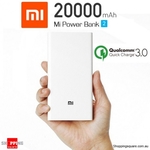A whopping 40c cheaper than the last deal. Good charger in both directions. Okay shipping can take ages sometimes, but its a bargain.
Xiaomi 20000mAh Dual USB Power Bank 2 Quick Charge 3.0 for $41.46 Delivered @ Shopping Square
Related Stores
closed Comments

My powerbank from SS was genuine. The code checked out online.

Yes have purchased 2 of these previously from SS from HK.

Anyone have link for a silicone cover for 2017 edition? I bought one for 20000mah xiaomi powerbank off ebay but the cover was way too big (must have been for 2016 or earlier edition). Thanks

With the quick charge 3.0, do they give us the charger thingo or just the cable and we have to get our own charger?

You mean the cable or the charger? You don't need the charger. This thing will do the charging. The cables you have to supply your own.

It comes with a flat approx. 300mm usb to micro usb cable.
Any wall charger will work. Obviously qc3 better than qc2 and 2.4A.

So to make full use of the qc3, I'll need the proper charger? The average phone charger rated at 2.1a and 5v just won't be as fast?

I don't think you understand what this thing does. But yes, if you want QC3 you have to use the charger that came with your phone, or a power bank with QC3 support.

they're asking if to charge this powerbank do you need to connect a QC3 charger at the power outlet for which the QC3 cable (or QC 2, or standard 2.4A old school phone cables) charges the powerbank.
Assumedly (given I don't know either) a normal wall charge can charge the powerbank, and all you need is the QC3 cable in order to have this QC3 enabled battery pack to charge your phone @hilariouspowerr

Are these really 20,000mAh? Someone mentioned they're really actually 16,000mAh.

Let's start a class action lawsuit against Xiaomi for false advertising. You in?

Nah sorry to poor to hire a lawyer

The battery cannot be discharged 100% or the battery fails. It has about 20% capacity reserve. So from the 20% to 100% it takes 16,000mAh to charge it. This means 20,000 total charge capacity. So it could be said that the battery holds 20,000mAh of which 16,000mAh is usable. However, the output of the battery is not 100% efficient. In actuality, this battery will provide around 12,000mAh of output to your devices.
Then marketers take the figures and report the biggest ones, because it sounds better.

Thanks for verifying that. No wonder why my 10,000mAh can only hold about 1.5 charge.

Dude this is wrong on so many levels I hope you stop spreading this around and misleading others.

Please enlighten us with the correct explanation then. Otherwise you're just as wrong as he is.
Edit: serves me right for not reading through it all.

Here, @m9. I will fix the text because you accuse me of misleading others. Please, with your infinite wisdom, advise if there is anything to debate.
The battery cannot be discharged 100% or the battery fails. It has about 20% capacity reserve because it is converted from 3.7V to 5V. So from the 20% to 100% it takes 16,000mAh to charge it. This means 20,000 total charge capacity. So it could be said that the battery holds 20,000mAh of which 16,000mAh is usable. However, the output of the battery is not 100% efficient. In actuality, this battery will provide around 12,000mAh of output to your devices.

Remember, that's based on 3.7V cell voltage and 5V USB output voltage. The Xiaomi powerbank here uses 3.85V cells, 5.1V USB output voltage with an efficiency of 93%. So (20000 X 3.85V / 5.1) X 0.93 = 14041mAh.

Please, with your infinite wisdom, advise if there is anything to debate.
You don't have to get all worked up when someone corrects you.
because it is converted from 3.7V to 5V
Again, this is wrong. These cells that Xiaomi uses are 3.85V cells, not 3.7V. And instead of the standard 5V USB output voltage, Xiaomi has bumped it up to 5.1V.
Proof? See here: https://s23.postimg.org/dv3mpjkih/image.jpg
In actuality, this battery will provide around 12,000mAh of output to your devices.
What can I say, this is wrong again. The "around" mark is 14,000mAh.

[I deleted it because this chatter belongs in forums, not as clutter in deal posts.]

Then you made some snide note about charge capacity "not amp hours" that was completely wrong.
You clearly do not get this. I said the correct unit for measuring energy capacity of a battery product is called watt-hours. The emphasis is on battery product - meaning battery packs such as this power bank, or even laptop batteries with multiple cells. It is inaccurate to judge the capacity by using just the mAh ratings, hence why Xiaomi included the Wh rating, or why laptop batteries often use Wh as well.
If you are comparing two 3.7V 18650 Li-ion cells, one with 2000mAh, the other is 3000mAh, then of course the latter will have a higher charge capacity. In this case sure, the Ah ratings can be used to determine that since both uses the same voltage.
When it comes to battery products, like this power bank, the mAh rating does not tell the full story. The previous version of this power bank, also advertised as 20,000mAh, has a lower 72Wh rating. This new version, also 20,000mAh, but has a higher 77Wh rating. The difference here is the higher cell voltage, hence why the newer version has a higher charge capacity. Hence why I said Wh is more suitable to be used to determine the charge capacity of a battery product.
Manufacturers know most consumers just look at the big mAh numbers so they just use that instead.

Short answer: Yes, they are 20,000mAh.
Long answer: The 20,000mAh rating is for the Li-ion cells themselves which have a 3.85V nominal voltage, and not for the USB output voltage at 5.1V. To determine the mAh at the output voltage, you first find the watt-hours (Wh):
20Ah X 3.85V = 77WhXiaomi claims conversion efficiency at 93%, therefore:
77Wh X 0.93 = 71.61WhUSB output voltage on this device is 5.1V, therefore:
71.61Wh / 5.1 = 14.04Ah or 14,041mAhNote: The correct unit for measuring energy capacity of a battery product is called watt-hours (Wh), not amp-hours (Ah).

You are adding a lot of techno mumbo jumbo with notes that are not even correct. Is it really helpful?
The energy stored in a battery, called the battery capacity, is measured in either watt-hours (Wh), kilowatt-hours (kWh), or ampere-hours (Ahr). The most common measure of battery capacity is Ah… http://pvcdrom.pveducation.org/BATTERY/capacity.htm
Above, you calculated 14,041mAh as the capacity. Xiaomi gives the minimum actual "output capacity" as "minimum 12700mAh" (at test conditions of 5V/1A output, 25°C) so you have some deficiency in your calculations. Did you consider the difference between storage capacity and output capacity that I touched on in my (downvoted) summary above, or can you explain the discrepancy in another way? http://global.mi.com/en/item/3160700004

You linked to the older 72Wh model (20Ah X 3.6V = 72Wh). The one being sold here is the newer 77Wh model which uses 3.85V cells (20Ah X 3.85V = 77Wh).
There's nothing to hide or add. Have a look at the highlighted info found on this listing: https://s23.postimg.org/dv3mpjkih/image.jpg
It clearly shows that this is the newer 77Wh model, uses 3.85V cells, with an efficiency of 93%, and actual output capacity of 14,000mAh.
Edit: I've just read your linked article. It also says: A more accurate approach takes into account the variation of voltage by integrating the AH capcity (sic) x V(t) over the the time of the charging cycle.
Ah only tells half the story and is only accurate if both battery systems uses the same voltage. 20Ah at 1V is not the same as 20Ah at 5V.
If you feel like reading, here's an easier article to digest: http://www.goalzero.com/solarlife/2013/05/28/clearing-up-the…

@lmh86: The strange thing about you claiming that it is "in line with" is that Xiaomi reports different figures on its website. It has a 20000 battery pack with "actual output capacity" of 12700mAh. http://www.mi.com/sg/pb20000/
At this point I suggest that ShoppingSquare has edited the graphics. At minimum, it added the red squares to draw attention to the fact that output capacity is not the same as storage capacity. Maybe the figures are provided by Xiaomi but as far as I have seen, they are not listed on any of Xiaomi's sites, and I checked the Global/Chinese/Singapore sites, which all state 12700mAh for 5.1V/1A.

@m9: From your links, I conclude that you feel that battery and solar marketing websites are good sources. However, I feel they are biased. You are free to continue to spread your justifications for marketing using the figures.
However, in my opinion, if someone gives back of the envelope calculations to a casual question about battery packs, that you should have dealt with it in the forums. Thanks for your time and real concern.

The strange thing about you claiming that it is "in line with" is that Xiaomi reports different figures on its website. It has a 20000 battery pack with "actual output capacity" of 12700mAh. http://www.mi.com/sg/pb20000/
Maybe the figures are provided by Xiaomi but as far as I have seen, they are not listed on any of Xiaomi's sites, and I checked the Global/Chinese/Singapore sites, which all state 12700mAh for 5.1V/1A.
That's the older YDDYP01 model. I'm sure someone has compared both new and old models on YouTube.

Sorry I'm not. I only linked to that article as it was easy to understand by many. Those are just simple calculations - no marketing wank involved.

@m9: Well, YouTube is not the manufacturer. Even if you're right, Xiaomi has not got any official figures in any language.

Maybe these pictures will help.
Bottom plate: http://attach.en.miui.com/forum/201612/23/004134ys77sx9at80k…
Internal cells: http://attach.en.miui.com/forum/201612/23/005335booiolo7isso…Taken from here: http://en.miui.com/thread-448321-1-1.html
Being a thread on the MIUI forum I guess there's some element of truth in it. 14000mAh 5.1V is just below the mega huge 20000mAh 3.85V.

@m9: Why would you think they help? I gave a figure of 12,000 mAh. In my opinion that's close enough to 14,347mAh, particularly since I was clearly using round numbers like 20%. Thanks for your attempt to help, I guess. But I do think that continued conversation should be reserved for the forums.

Was hoping you will let go of the incorrect figure since the product clearly shows 14000mAh. No worries. See you around.

Clearly says in the link actual capacity is 14000mah for the reasons already mentioned

In any case, Xiaomi should not be advertising 20,000mAh in big numbers if 20% of it is not even useable.

I got this last time when they had a sale on them around $35, definitely recommend!
Have brought it overseas with me a couple of times no issues, USA and Bali. I calculated the max allowance limit you're allowed to carry for batteries vs this one was around 60% the limit approximately. I have managed to charge my iphone 6, 4 times to 100% no issues

Is this expired? Price seemed to have bumped up again

Please check the price

I bought this deal and they sent some shitty cheap imitation power bank and tried to pass it off as the same. Beware.


Does SS send genuine stock?
I bought from Aliexpress and it was not.